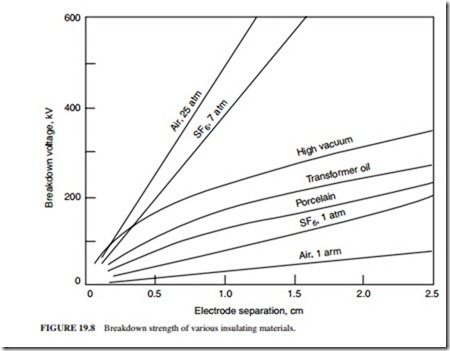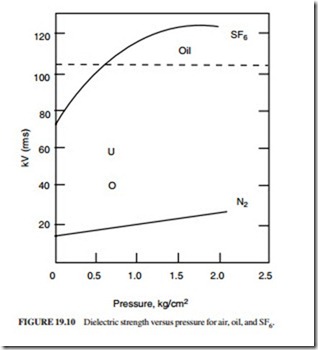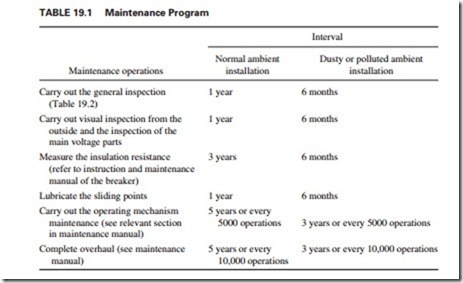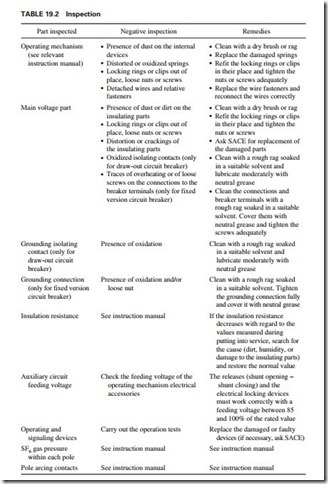RECENT DEVELOPMENTS IN CIRCUIT BREAKERS
Vacuum Circuit Breakers
The two outstanding properties of high vacuum are that
1. It has the highest insulating strength known.
2. When an ac circuit is opened by separating the contacts in vacuum, interruption occurs at the first current zero. The dielectric strength across the contacts builds up at a rate thousands of times higher than that obtained with conventional circuit breakers.
These properties make the vacuum circuit breakers more efficient, less bulky, and cheaper.
The service life of these breakers is much longer than that of conventional circuit breakers. The maintenance required for these breakers is minimal. Low vacuum pressures are measured in terms of torr, where 1 torr = 1 mm of mercury. Pressures as low as 10-7 torr can be achieved.
When contact separation occurs in air, the ionized molecules are the main carriers of electric charges. They are responsible for the low breakdown value. The absence of air molecules increases the dielectric strength of vacuum significantly. Figure 19.8 illustrates the breakdown strength of various insulating materials.
Construction of Vacuum Switch/Circuit Breakers. The vacuum circuit breaker is a very simple device when compared with oil or air-blast circuit breakers. Two contacts are mounted inside an insulating vacuum-sealed container. One is fixed and the other could be moved through a very short distance. The contacts are surrounded by a metallic shield that protects the insulating container. A typical assembly of a vacuum switch is shown in Fig. 19.9.
Vacuum Chamber. It consists of the following subassemblies:
1. The vacuum chamber
2. The operating mechanism
The vacuum chamber is usually made of synthetic material such as urethane foam. It is enclosed in an outer glass-fiber-reinforced plastic tube or of simple glass or porcelain. It has two contacts, a metal shield and metal bellows, which are sealed inside the chamber. The metallic bellows are usually made of stainless steel. The metallic bellows are used to move the lower contact and provide a gap of 5 to 10 mm depending upon the application of the switch.
Application of Vacuum Switches. The vacuum switches have a promising application in the high-voltage switchgear field. They are distinguished for their low cost, low fault interrupting capacity, and capability of a large number of load switching operations with- out maintenance. They are very high-speed switches and can be used for many industrial applications. They are well suited up to 35-kV and 100-MVA applications.
Sulfur Hexafluoride (SF6) Circuit Breakers
The SF6 circuit breaker is the most recent development in the field of high-voltage switch- gear. SF6 is a gas that is 5 times heavier than air. It is chemically very stable, odorless, inert, noninflammable, and nontoxic.
SF6 and its decomposition products are electronegative. They capture electrons at relatively high temperature. Therefore, the dielectric strength rises rapidly and enables the breaker to withstand the recovery voltage even under extreme switching conditions.
SF6 circuit breakers do not allow the gas to escape, as do air-blast circuit breakers fol- lowing the quenching operation. The circuit breaker chambers are hermetically sealed. The gas pressure remains practically constant over long periods.
The SF6 gas has low contact erosion and negligible decomposition in arc. The breaker can be operated for several years without having to be opened for the purpose of overhauling. At atmospheric pressure, the dielectric strength of SF6 is about 2.5 times that of air. Figure 19.10 illustrates the variations of the dielectric strength with pressure for air, oil, and SF6.
The dielectric strength of SF6 is less than that of oil at atmospheric pressure. However, it increases rapidly with pressure. The gas is strongly electronegative. Free electrons are readily removed from a discharge by the formation of negative ions.
The following are the processes by which a free electron is attached to a neutral gas molecule:
1. A direct attachment as in
The resulting ions are heavy and ineffective carriers of current. Therefore, the ionized SF6 has also a high dielectric strength.
Maintenance of SF6 Breakers
Storage. Keep the breaker in a room protected from adverse conditions such as excessive humidity, dust, or corrosive chemical agents and sudden temperature changes.
Description. The SF6 is an arc extinguishing and insulating medium. The chemical properties of the gas make SF6 breakers suitable for indoor installation. SF6 breakers have separate poles (one per phase). The active parts of the poles are housed in insulating cylinders (one per pole).
Each insulating cylinder is filled with SF6 gas (electronegative gas), which is used because of its dielectric properties and its capacity to extinguish the arc quickly. The gas pressure is usually around 3.4 bar absolute referred to a temperature of 20°C.
During the breaker opening operation, the combined action of mechanical devices with that of the arc itself, which develops between the arcing contacts in each pole, creates a forced circulation of gas that blows the arc, causing its extinction.
The SF6 gas is neither flammable nor explosive. Therefore, its use does not cause fire or explosion risks. The SF6 circuit breakers have proved to be highly reliable under different circuit conditions. They are suitable for the most stringent duties (including high-humidity environment). The electrical life of the breaker depends on its usage and is in relation to the arcing contact wear. The SF6 gas is not notably affected by current interruptions.
Pole Characteristics. The pole is made of an insulating cylinder from which the upper and lower terminals come out. At the base of the cylinder, there is
1. The pole operating shaft
2. The gas filling valve
3. The pressure switches
The moving part is composed of
1. The arcing contact
2. The blowing nozzle
3. The moving tubular contact
4. The insulating tie-rod
The guiding contact provides the current passage between the moving tubular contact and the lower fixed main contact. The tubular contact is moved by an insulating tie-rod which is linked to the pole operating shaft with a lever. The pole operating shaft is provided with a lever externally which is connected to the output shaft of the operating mechanism via transmission tie-rods.
The gas is sealed on the shaft by a double gasket with a suitable liquid interposed. The pres- sure switches monitor the gas pressure in the pole. If the gas pressure drops below the preset value of the pressure switch, the built-in changeover contact will operate to annunciate an alarm.
Note:
1. The preset limit to provide an alarm is 2.5 bar absolute.
2. The breaker metal frame should be connected to ground.
Maintenance
Caution. Before carrying out any maintenance work, workers must ensure the fol- lowing actions have been taken:
1. Open (off ) the circuit breaker.
2. For draw-out or disconnectable circuit breaker, the work must be done only when they are withdrawn from the compartment.
3. With circuit breakers in fixed version or for maintenance on the enclosures or fixed parts, deenergize the following:
a. The main voltage circuits connected to them.
b. Auxiliary circuits.
Also, connect all main voltage terminals (on both the supply and the load side) to ground in a clearly visible manner.
General. During normal service, only limited maintenance is required for the circuit breakers. The burden of service duty determines the frequency of inspections and mainte- nance. It is advisable to follow these rules:
1. Equip the circuit breaker with an operation counter.
2. For circuit breakers that will operate only a few times or that will remain closed (on) or open (off ) for long periods, the breaker should be operated from time to time to prevent a tendency to clog which may cause reduction in the closing or opening speed.
3. During service, visually inspect the circuit breaker from the outside to detect any dust, dirt, or damage of any kind.
Maintenance Program. Table 19.1 illustrates the maintenance program for the SF6 circuit breaker.
General Inspection of the Circuit Breaker. Table 19.2 shows the general inspection required for the circuit breaker.
Lubrication. All sliding parts subject to friction must be lubricated at the required frequency with MU-EPIAGIP grease or equivalent.
Checking the Gas Pressure within the Poles. Refer to the appropriate section in the maintenance manual.





